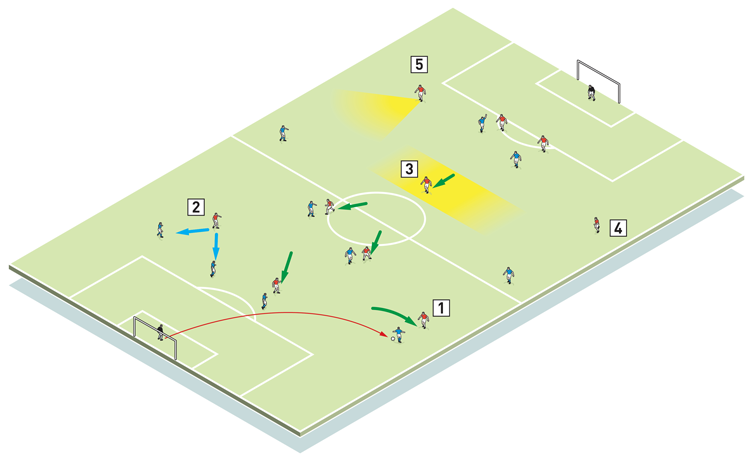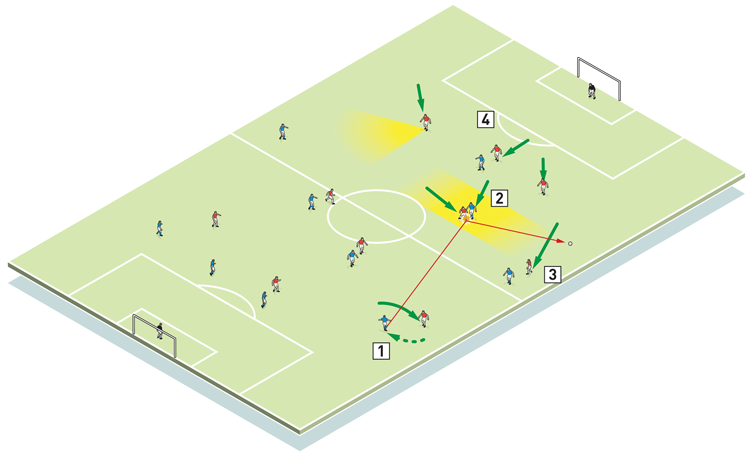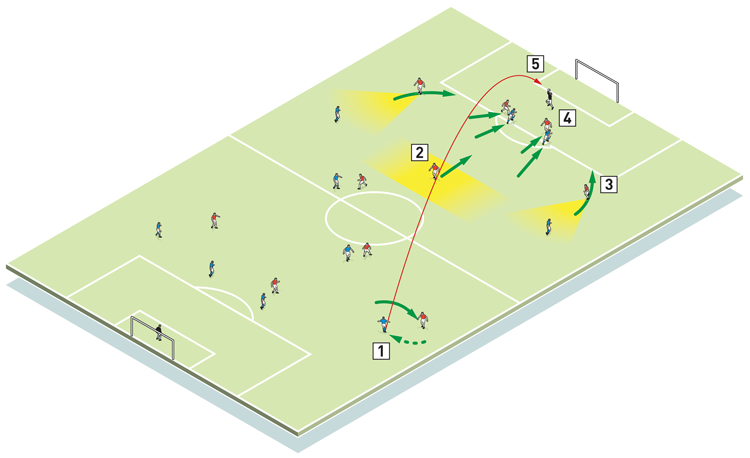




OUR BEST EVER OFFER - SAVE £100/$100
JOIN THE WORLD'S LEADING PROFESSIONAL DEVELOPMENT PROGRAMME
- 12 months membership of Elite Soccer
- Print copy of Elite Player & Coach Development
- Print copy of The Training Ground
You are viewing 1 of your 1 free articles
Defending from the front in a 4-3-3 situation
Coach players on understanding defensive positioning. Show them how to channel opposition passes into areas of strength, where they can attempt to turn possession over.
| Area | Full pitch |
| Equipment | Balls, cones, goals |
| No. of Players | 11v11 |
| Session Time | As long as required |
This session coaches players on understanding defensive positioning. It enables us to teach how to channel opposition passes into areas of strength for us, where we can attempt to turn possession over. Furthermore, it gives players an idea of which passes we can allow and which should be prevented.
As a result, the session will help prevent us from being overstretched, or exposed to positions of vulnerability.
What do I get the players to do?
We set up as shown, 11v11, on a full pitch, with teams lining up in 4-3-3 (reds) and 4-4-2 (blues) formations. The opposition keeper starts play by throwing the ball out to his right-back.
What follows is the gradual learning of a bespoke coaching set-up, with players understanding their roles, both as individuals and banks of players.
By following this outline closely, we can successfully defend from the front in a 4-3-3, as well as still retaining the positive attacking elements that are so prevalent in this offensive formation.
A common problem is when the striker allows the full-back to play the pass into the wide man, enabling the opposition to start their attack. To prevent this we put in place a key part of defending from the front – namely that our striker has to arc his run so as to cut off the line from the full-back to the wide man, forcing him to play inside or backwards (1).
1

1. The first wide striker moves to block a pass wide
2. The other wide striker covers the threat of a cross-field pass
3. The holding midfielder covers the central area
4. The left full-back should move forward to cover the wide player in the event of the ball going in to him 5. Defending full-backs can hold the line, but must stay aware of the winger
As soon as the striker locks into the right-back, that is the trigger for his team mates to move forward and press. The central striker is aware of the other centre-back, or is in a position to stop a cross-field pass to the left-back (2).
2

1. The defending full-back moves to challenge
2. The holding midfielder moves in to block a pass infield to the strikers
3. The back four moves across to cover
Two centre-midfielders mark ‘ball side’ and press inside the ball. The deeper centre-midfielder stops any long ball into the strikers (3).
3

1. The attacking full-back moves infield to make room for the pass
2. The holding midfielder covers the run of the striker
3. The defending full-back moves up to cover the winger
4. The back four moves across and out
Centre-backs hold a deeper line so as not to be turned around. The right-back doesn’t have to go tight to the winger or right-back on cover, but remains aware of the diagonal ball. The keeper sweeps up any longer ball (4).
4

1. The attacking full-back moves infield to make room for the pass
2. The holding midfielder drops back to cover late runs by attacking midfield players
3. The defending full-backs recover, being aware of the winger overlapping
4. Central defenders cover the runs of the strikers
5. The keeper collects
What are the key things to look out for?
The set-up succeeds or fails on the basis of players knowing their roles and responsibilities when defending from the front. Through intense and repeated coaching, each player can cement his part in the process and, as a result, can create a definite team principle of suffocating the threat that comes when the opposition is in possession.
Related Files
Editor's Picks
Attacking transitions
Deep runs in the final third
Using the goalkeeper in build-up play
Intensive boxes drill with goals
Penetrating the final third
Creating and finishing
My philosophy
Pressing initiation
Compact team movement
Coaches' Testimonials

Alan Pardew

Arsène Wenger

Brendan Rodgers

Carlos Carvalhal

José Mourinho

Jürgen Klopp

Pep Guardiola

Roy Hodgson

Sir Alex Ferguson

Steven Gerrard
Related
Coaches' Testimonials

Gerald Kearney, Downtown Las Vegas Soccer Club

Paul Butler, Florida, USA

Rick Shields, Springboro, USA

Tony Green, Pierrefonds Titans, Quebec, Canada
Join the world's leading coaches and managers and discover for yourself one of the best kept secrets in coaching. No other training tool on the planet is written or read by the calibre of names you’ll find in Elite Soccer.
In a recent survey 92% of subscribers said Elite Soccer makes them more confident, 89% said it makes them a more effective coach and 91% said it makes them more inspired.
Get Monthly Inspiration
All the latest techniques and approaches
Since 2010 Elite Soccer has given subscribers exclusive insight into the training ground practices of the world’s best coaches. Published in partnership with the League Managers Association we have unparalleled access to the leading lights in the English leagues, as well as a host of international managers.
Elite Soccer exclusively features sessions written by the coaches themselves. There are no observed sessions and no sessions “in the style of”, just first-hand advice delivered direct to you from the coach.







